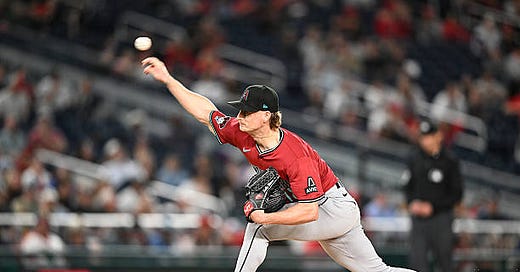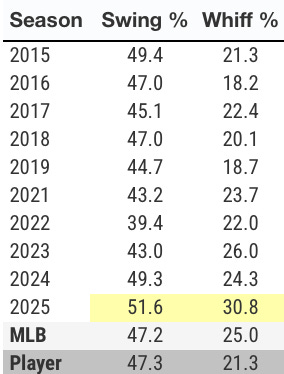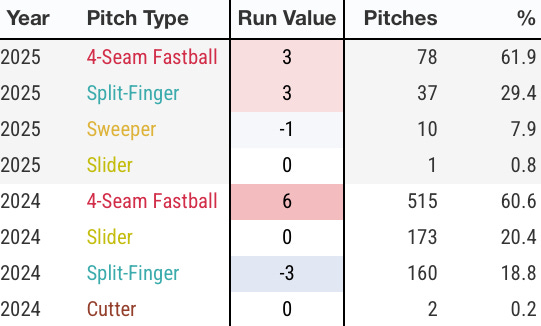Shelby Miller: Fastball command, at-bat control, and reach with feet
We learn about extension and how silly previews can be
Shelby Miller has spent 16 years in professional baseball. After a brief run as a starter for the Cardinals and Braves, the last decade of his career has been in the bullpen. Almost 40% of his career innings pitched have been in the minor leagues. Everything points to Miller being a AAAA player; excelling in the minors, yet not quite being what’s needed out of a major league reliever. In my preview of the Diamondbacks’ bullpen, I noted Miller’s propensity to give up home runs as a concern for the 2025 season. Based on his 2024 season, I didn’t see him as an improvement on a bullpen that needed to improve (51 G, 55.2 IP, 4.48 FIP, 9 HR). So far, I couldn’t have been more wrong.1
This season has started with a different story. Miller has been reliable and dominant (10 G, 10.2 IP, 1.89 FIP). If the changes are real, the focus will be on his ability to prevent runs instead of giving them up.
Control over hitters
Starting at-bats with a strike keeps the pitcher in control throughout the at-bat. Miller is able to attack hitters the way he wants to, which keeps himself in favorable counts and minimizes damage hitters can cause when they make contact. Pitchers that get ahead in counts are more likely to get batters out, and Miller’s career-high first pitch strike rate has kept him in the driver’s seat so far this season.
Missing bats
The best part for a pitcher that misses bats is that nobody can take extra bases. Miller is at a career high for swings against his pitches, as well as whiffs. The art of pitching is what’s captured here; a pitch must look good enough to convince a hitter to swing, but not get the result they expect (whiff, weak contact, etc). If hitters start making contact, things could get ugly quickly. Right now, Miller’s stuff looks good to hitters, but it actually isn’t.
Improved Fastball
The increased fastball velocity also is connected to the change in movement. A pitch thrown harder will not drop as much, but could move more horizontally depending on the release point of the pitcher. This has made Miller’s fastball more effective. Looking at run value, his 4-seam fastball is almost 4 times as effective as it was last year. When a pitcher’s primary pitch gets more strikes and outs, the secondary pitches will always look good.
Overhauled repertoire
2024 shows Miller using three pitches: a fastball (4-seam), breaking ball (slider), and offspeed (split-finger). This year has seen an emphasis on the splitter against the fastball, which has been more effective against hitters this season. I think the lack of a pitch with intermediate break and velocity is what makes it tougher for a hitter to figure out Miller so far. This also explains why the sweeper has been a better option than Miller’s slider. He offers a pitch focused on horizontal break, a pitch focused on vertical drop, and an effective fastball.
Using his legs to pitch better
Ext is Extension, the distance a pitcher’s release point is from the front of the pitching rubber. Miller’s average extension is one of the largest in baseball (93rd percentile, 7.1 inches). The additional reach with his front foot gives hitters slightly less time to react to a pitch. This also gives Miller more push off the rubber with his back foot, generating slightly more force with each pitch. A small increase in velocity and extension can make a pitch appear significantly harder to hit. Miller might be showing us that the idea of throwing with your whole body is essential for a pitcher.
Another piece of the long stride and extension is the lack of baserunners Miller has allowed. Runners on base demand a pitcher’s attention, requiring a shorter stride and less extension from the mound. The additional extension could be indicative of more pitches without baserunners or basestealing threats. Only time and baserunners will tell.
I knew when I did previews during spring training that I’d miss some analysis. I did not expect it this quickly.











It just goes to show that Lou Piniella was right: "Statistics are like bikini's. They show you a lot but not everything."